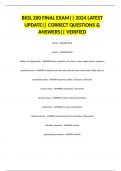BIOL 200 FINAL EXAM|| 2024 LATEST
UPDATE|| CORRECT QUESTIONS &
ANSWERS|| VERIFIED
dorsal - ANSWER back
ventral - ANSWER belly
Pattern of Organization - ANSWER atom, molecule, cell, tissue, organ, organ system, organism
epithelial tissue - ANSWER A body tissue that covers the surfaces of the body, inside and out
connective tissue - ANSWER supports, binds, transports, immunity
muscle tissue - ANSWER contraction, movement
nervous tissue - ANSWER conducts electrical impulses
Asymmetry - ANSWER no axis of orientation
radial symmetry - ANSWER oral-aboral axis of orientation, (flowerpot)
briradial symmetry - ANSWER circular
pentaradial symmetry - ANSWER starfish
,bilateral symmetry - ANSWER different planes, transverse plane, median plane, frontal plane. can be split
into dorsal, posterior and anterior.
unicellular - ANSWER single cell or cellular aggregates, not alot of cellular specialization, protists
diploblastic organization - ANSWER cells organized into rudimentary tissues, two embryonic cell layers,
ectoderm and endoderm and mesoglea
triploblastic organization - ANSWER 3 layers, ectoderm, endoderm, mesoderm. there is a coelom, which
is a body cavity surrounded by mesoderm, 3 different patterns- acoelomte animals, pseudocoelomate
animals, and coelomate animals.
protostomes (triploblastic) - ANSWER spiral cleavage, blastopores develop into mouth, schizocoelous
coelom, trochophore larva
Deuterostomes (triploblastic) - ANSWER radial cleavage, blastopore develops into anus, entercoelous
coelom, no trochophore larva
Protist Evolution - ANSWER all groups presented by cambrian period and are polyphyletic
four supergroups contain animal like forms, some species are animal like and plant like.
animal like protist - ANSWER unicellular, have a pellicle composed of microtubules.
asexual reproduction for protists - ANSWER binary fission (can split in different ways)
schizogony (mitotic division)
budding (can come off of a cell, some generative atomical point of the parent)
sexual reproduction in protists - ANSWER variation amoung taxa
gametes are produced by haploid individuals
mesiosis shortly after zygotic meiosis
sex unknown in some forms (Amoebozoa)
, supergroup excavata - ANSWER excavated groove on one side of the cell body for feeding,
phytoflagated/ zooflagellated
modified mitochondria and are anaerobic (with oxygen)
can be pathogenic to humans
ciliates (alveolata) - ANSWER freshwater and marine
free living
cilia (locomotion and feeding)
fixed morphology
distinct cytosome
asexual reproduction by transverse fission and sexual reproduction by conjugation
dimorphic nuclei
apicomplexans (alveolata) - ANSWER intracellular parasites (Plasmodium, Cryptosporidum, Toxoplasma)
ring shapped apical complex
no cillia/flagella
metazoa - ANSWER multicellular most likely monophyletic
common features of the metazoa - ANSWER presence of mono-flagellated cells
mitotic aster apparatus
cell junctions
proteins associated in movement
Multicellarity - ANSWER composed of cells that are connected, have specialized fucntions and
communicate and cooperate.
arose many times in eukaryotes
advantages in increased size




